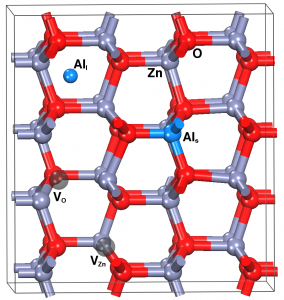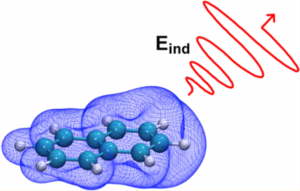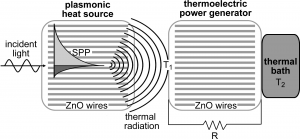1. PLASMONIC AND HYPERBOLIC METAMATERIALS
This activity started in 2010 is dedicated to the investigation of materials, alternative to standard noble metals, for the realization of plasmonic systems and optical metamaterials, active in the visible and mid/near-IR.
i. Inorganic bulk materials
 This research deals with the high-throughput discovery and the characterization of the electronic and optical properties of plasmonic materials, based on first-principles (TD)DFT simulations.
This research deals with the high-throughput discovery and the characterization of the electronic and optical properties of plasmonic materials, based on first-principles (TD)DFT simulations.
Materials of interest are:
transparent conductors (e.g. Al:ZnO, Al-ZnS, InSnO, Ag-halides, Ta:TiO2, ITO), refractive ceramics, (e.g TiN, ZrN, TiC, ZrC), phase change materials (e.g. VO2, GeTe) and high entropy carbides. Particular attention is dedicated to the effects of composition, defects, dopants and impurities on the optical and plasmonic properties of these materials, also through the simulation of X-ray and electronic spectroscopies (e.g. XPS, NEXAFS, UV-vis, EELS).
Collaborations: S. Curtarolo (Duke University, USA); D. E. Wolfe (Penn State University, USA); A. Boltasseva e V. Shalaev (Purdue University, USA); E. Della Gaspera (RMIT University, Melbourne, AU); S. Cueff (CNRS, FR); A. Li Bassi (Politecnico Milano, IT); S. Benedetti (CNR-NANO, IT)
Main References
[1] A. Calzolari, C. Oses, C. Toher, M. Esters, X. Campilongo, S. P. Stepanoff, D. E. Wolfe, S. Curtarolo, Nature Communication (2022), in press.
[2] A. Calzolari, A. Catellani, M. Buongiorno Nardelli, and M. Fornari, "Hyperbolic metamaterials with extreme mechanical hardness", Adv. Opt. Mater. 9, 2001904 (2021).
[3] J. John, A. Slassi, J. Sun, Y. Sun, J. Penuelas, G. Saint-Girons, R. Orobtchouk, S. Ramanathan, A. Calzolari, and S. Cueff "Tunable Optical Anisotropy in Epitaxial Phase-Change VO2 Thin-Films", NanoPhotonics 11, 3913 (2022).
[4] D. Shah, A. Catellani, H. Reddy, N. Kinsey, V. Shalaev, A. Boltasseva, and A. Calzolari, "Controlling the plasmonic properties of ultrathin TiN films at the atomic level", ACS Photonics 5, 2816 (2018).
[5] A. Catellani and A. Calzolari, "Plasmonic properties of refractory titanium nitride", Phys. Rev. B 95, 115145 (2017)
[6] A. Calzolari, A. Ruini, and A. Catellani. "Transparent conductive oxides as near-IR plasmonic materials: the case of Al-doped ZnO derivatives", ACS Photonics 1, 703 (2014).
ii. Plasmonics in ultrasmall nanostructures
 This study, based on TDDFT, deals with quantum mechanical definition of the plasmonic character of the optical excitations in ultrasmall nanostructures, such as metallic clusters (e.g. Au, Ag, Na) and conjugated molecules (e.g. polyacenes, J-aggregates), through the definition of new descriptors, like the plasmonicity index or the field amplification index
This study, based on TDDFT, deals with quantum mechanical definition of the plasmonic character of the optical excitations in ultrasmall nanostructures, such as metallic clusters (e.g. Au, Ag, Na) and conjugated molecules (e.g. polyacenes, J-aggregates), through the definition of new descriptors, like the plasmonicity index or the field amplification index
Collaborations: S. Corni (Univ. Padova, IT), E. Molinari (UNIMORE,and CNR-NANO, IT), L. Bursi and P. Nordlander (Rice University, USA) e M. Stener (Univ. Di Trieste, IT).
Main References
[1] R. Zhang, L. Bursi, J. D. Cox, Y. Cui, C. M. Krauter, A. Alabastri, A. Manjavacas, A. Calzolari, S. Corni, E. Molinari, E. A. Carter, F. J. García de Abajo, H. Zhang, and P. Nordlander, "How to Identify Plasmons from the Optical Response of Nanostructures", ACS Nano 11, 7321 (2017).
[2] O. Baseggio, M. De Vetta, G. Fronzoni, M. Stener, L. Sementa, A. Fortunelli, and A. Calzolari, "Photoabsorption of Icosahedral Noble Metal Clusters: An Efficient TDDFT Approach to Large-Scale Systems", J. Phys. Chem. C 120, 12773 (2016).
[3] L. Bursi, A. Calzolari, S. Corni and E. Molinari, "Quantifying the plasmonic character of optical excitations in nanostructures from first principles", ACS Photonics 3, 520 (2016).
2. AMORPHOUS MATERIALS FOR STORAGE-CLASS MEMORY DEVICES
 This field of research is dedicated to the study of disordered materials for disruptive nanoelectronic solutions, such as the synaptic electronics and neuromorphic computing. Modelling of these devices, e.g. e phase-change memory (PCM), and selectors, rely on the investigation of materials at device level, where sub stoichiometric, defect aggregation and their (thermo)dynamics play a crucial role in the definition of the material itself. Studied materials include Ovonic Threshold Switching chalcogenides (GeSe, GST) and transition metal-oxides (HfO2, WO3).
This field of research is dedicated to the study of disordered materials for disruptive nanoelectronic solutions, such as the synaptic electronics and neuromorphic computing. Modelling of these devices, e.g. e phase-change memory (PCM), and selectors, rely on the investigation of materials at device level, where sub stoichiometric, defect aggregation and their (thermo)dynamics play a crucial role in the definition of the material itself. Studied materials include Ovonic Threshold Switching chalcogenides (GeSe, GST) and transition metal-oxides (HfO2, WO3).
Collaborations: L. Larcher (Appl. Mater. Italia), P. Ordejon (ICN2, ES), N. Marzari (EPFL, CH), S. Clima (IMEC, BE), A. Padovani (Univ. Modena and Reggio E, IT).
Fundings: EU H2020 project INTERSECT; EU H2020 project OpenModel.
Main References
[1] F. Tavanti and A. Calzolari, "A multi-technique approach to unravel the (dis)order in amorphous materials", ACS Omega 7, 23255 (2022).
[2] F. Tavanti, B. Dianat, A. Catellani, and A. Calzolari, "Hierarchical short- and medium-range order structures in amorphous GexSe1-x for selectors applications", ACS Appl. Elec. Mater. 2, 2961 (2020).
[3] B. Dianat, F. Tavanti, A. Padovani, L. Larcher, and A. Calzolari, "BELLO: a post-processing tool for the local-order analysis of disordered systems", Compt. Mater. Sci. 209, 111381 (2022).
3. MATERIALS FOR ENERGY CONVERSION
 This activity is dedicated to the study of advanced materials for energy conversion. Materials of interest include both soft-mattter compounds and fibers (e.g. PVD-TrFE, PEDOT-Tos, graphene) for piezoelectric and thermoelectric applications at room temperature, as well as inorganic nanostructures (e.g. In:ZnO) for plasmon-assisted thermoelectric applications. The role of dopants/impurities is extensively took into account. This studies rely on original finite-difference/finite-field approaches for the evaluation of both polarizability and vibrational spectra of materials.
This activity is dedicated to the study of advanced materials for energy conversion. Materials of interest include both soft-mattter compounds and fibers (e.g. PVD-TrFE, PEDOT-Tos, graphene) for piezoelectric and thermoelectric applications at room temperature, as well as inorganic nanostructures (e.g. In:ZnO) for plasmon-assisted thermoelectric applications. The role of dopants/impurities is extensively took into account. This studies rely on original finite-difference/finite-field approaches for the evaluation of both polarizability and vibrational spectra of materials.
Collaborations: D. Pisignano (Univ. Pisa, IT), L. Persano (CNR-NANO, IT), M. Buongiorno Nardelli (Uni. North Texas, USA)
Main References
[1] L. Cigarini, A. Ruini, A. Catellani, and A. Calzolari, "Conflicting effect of chemical doping on the thermoelectric response of ordered PEDOT aggregates", Phys. Chem. Chem. Phys. 20, 5021 (2018).
[2] L. Persano, A. Catellani, C. Dagdeviren, Y. Ma, X. Guo, Y. Huang, A. Calzolari, and D. Pisignano,"Shear piezoelectricity in poly(vinylidenefluoride-co-trifluoroethylene): full piezotensor coefficients by molecular modeling, biaxial transverse response, and use in suspended energy-harvesting nanostructure", Adv. Mater. 28, 7633 (2016).
[3] A. Catellani, A. Ruini, M. Bongiorno Nardelli, and A. Calzolari, "Unconventional co-existence of plasmon and thermoelectric activity in In: ZnO nanowire", RSC Adv. 5, 44865 (2015).
[back]
